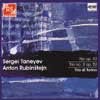Rubinstein;Taneyev Piano Trios
Competently played versions of music that shows little distinction
View record and artist detailsRecord and Artist Details
Composer or Director: Anton (Grigor'yevich) Rubinstein, Sergey Ivanovich Taneyev
Genre:
Chamber
Label: Real Sound
Magazine Review Date: 9/2003
Media Format: CD or Download
Media Runtime: 71
Mastering:
Stereo
DDD
Catalogue Number: RS0510093

Tracks:
| Composition | Artist Credit |
|---|---|
| Piano Trio |
Sergey Ivanovich Taneyev, Composer
Sergey Ivanovich Taneyev, Composer Trio di Torino |
| Piano Trio No. 3 |
Anton (Grigor'yevich) Rubinstein, Composer
Anton (Grigor'yevich) Rubinstein, Composer Trio di Torino |
Author: David Fanning
Like so much of his estimable chamber music production, Sergey Taneyev’s D major Trio of 1907 is hard not to respect, but harder still to get excited about. Each movement starts promisingly enough, but it is difficult to sustain interest in music that has so few surprises in store and so little distinction of temperament, music that could have been produced by so many composers – provided only that they were competently trained – in so many countries and in such a wide time-frame. The all-purpose idiom seems to have been designed mainly for the recreation of musicians who never quite outgrew their cloistered conservatoire days. Nevertheless, the slow movement has some strikingly tender moments, and the exuberant finale coda is well worth waiting for.
Anton Rubinstein’s Trio of 1857, one of the five he composed between 1851 and 1883, typifies his internationalist idiom – ‘Mendelssohnacidic-Schumannoxide’, as one wag dubbed it. This piece is also at its best in the slow movement, reminding us that Rubinstein, like Taneyev, had a genuine gift for the long structural line: something not granted to many of their compatriots. The trouble is that this brings him into direct competition with the German masters, who could do this sort of thing in their sleep.
The strings in the Trio di Torino are attractively sweet-toned. Nor is the piano playing in any way to be sneezed at, though this disc is no great advertisement for the Kawai instrument, which is too immediate and unsubtle in tone for this repertoire. The recording itself is somewhat overblown, with so much hall ambience that it is hard at times to concentrate on the music.
Anton Rubinstein’s Trio of 1857, one of the five he composed between 1851 and 1883, typifies his internationalist idiom – ‘Mendelssohnacidic-Schumannoxide’, as one wag dubbed it. This piece is also at its best in the slow movement, reminding us that Rubinstein, like Taneyev, had a genuine gift for the long structural line: something not granted to many of their compatriots. The trouble is that this brings him into direct competition with the German masters, who could do this sort of thing in their sleep.
The strings in the Trio di Torino are attractively sweet-toned. Nor is the piano playing in any way to be sneezed at, though this disc is no great advertisement for the Kawai instrument, which is too immediate and unsubtle in tone for this repertoire. The recording itself is somewhat overblown, with so much hall ambience that it is hard at times to concentrate on the music.
Discover the world's largest classical music catalogue with Presto Music.

Gramophone Digital Club
- Digital Edition
- Digital Archive
- Reviews Database
- Full website access
From £8.75 / month
Subscribe
Gramophone Full Club
- Print Edition
- Digital Edition
- Digital Archive
- Reviews Database
- Full website access
From £11.00 / month
Subscribe
If you are a library, university or other organisation that would be interested in an institutional subscription to Gramophone please click here for further information.




